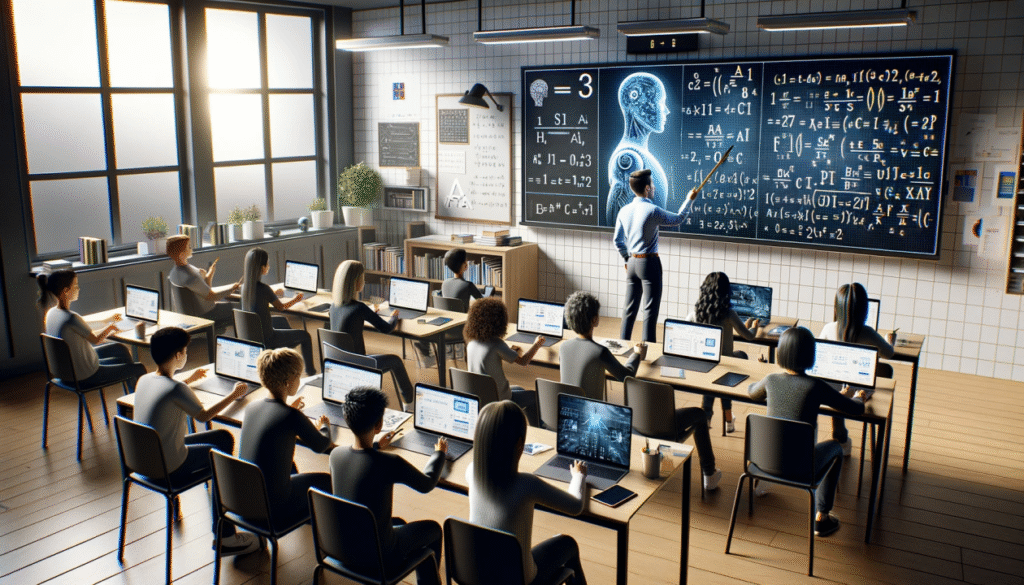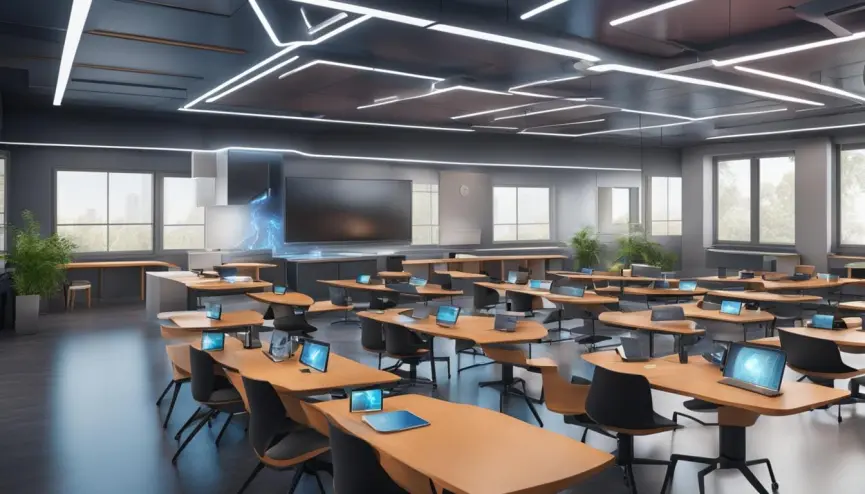Introduction: Why Talk About AI in Education?
Artificial Intelligence in Education has always been about passing knowledge from one generation to the next. But the way we teach and learn has changed dramatically over the years—from chalkboards to smartboards, from textbooks to e-learning platforms. Now, we’re entering a new era where Artificial Intelligence (AI) is becoming a central player in classrooms, universities, and even self-learning apps.
AI in education isn’t just a futuristic idea—it’s already here. From personalized learning apps like Duolingo to AI-powered grading systems used in universities, the technology is reshaping how students learn and how teachers teach.
But here’s the big question: Is AI in education a blessing or a curse? Let’s dive deep into the positives, negatives, real-world applications, and future possibilities.
The Rise of Artificial Intelligence in Education

A Quick Look Back
AI in education didn’t appear overnight. Early computer-assisted learning programs in the 1960s were the first step. Over time, as machine learning and natural language processing advanced, AI became capable of analysing student performance, predicting outcomes, and even generating personalized lesson plans.
Why AI Feels Like a Game-Changer
Unlike traditional tools, AI doesn’t just deliver content—it adapts, learns, and responds. That’s what makes it revolutionary. It can:
- Adjust lessons to each student’s pace
- Automate repetitive teacher tasks
- Provide real-time feedback
- Make learning more inclusive
Positive Impacts of AI in Education
Personalized Learning for Every Student
One of the biggest strengths of AI is personalization. In a traditional classroom, one teacher may have 40 students, each with different learning speeds. AI solves this by:
- Tracking student progress in real time
- Offering customized exercises
- Recommending resources based on strengths and weaknesses
Example: Duolingo adjusts difficulty levels automatically, ensuring learners stay challenged but not frustrated.
Intelligent Tutoring Systems (ITS)
AI tutors are like having a 24/7 personal assistant for learning. They can explain concepts, answer questions, and guide students step by step.
- Pro: Students get instant feedback anytime.
- Con: They lack the emotional intelligence of a human mentor.
Automating Teacher Workload
Teachers spend hours grading papers, tracking attendance, and preparing reports. AI can handle:
- Automated grading (especially for multiple-choice and short answers)
- Attendance tracking with facial recognition
- Scheduling and resource management
This frees teachers to focus on creativity, mentorship, and emotional support.
Making Education More Inclusive
AI is a game-changer for accessibility. Tools like speech-to-text, real-time translation, and AI-driven sign language recognition help:
- Students with disabilities
- Non-native language learners
- Students in rural or remote areas
Data-Driven Insights for Better Outcomes
AI can analyse patterns and predict which students are at risk of dropping out. Schools can then intervene early with support programs.
Negative Impacts and Challenges of AI in Education
Over-Reliance on Technology
If students depend too much on AI tutors, they may lose the ability to think critically and solve problems independently.
Privacy and Data Security Issues
AI systems collect massive amounts of student data. This raises concerns:
- Who owns the data?
- How secure is it?
- Could it be misused for profit?
Algorithmic Bias
AI is only as good as the data it’s trained on. If the data is biased, the system may:
- Misjudge student abilities
- Reinforce stereotypes
Create unfair grading outcomes
The Missing Human Touch
Education is not just about academics—it’s about empathy, mentorship, and emotional growth. AI cannot replace the human connection between teacher and student.
Cost and Accessibility Barriers
While AI promises inclusivity, advanced AI tools are expensive. Many rural schools or underfunded institutions cannot afford them, creating a digital divide.
Real-World Applications of AI in Education
AI-Powered Learning Platforms
- Duolingo: Personalized language learning
- Khan Academy: Adaptive practice exercises
- Coursera: Course recommendations based on learner behavior
Virtual Classrooms and Smart Content
AI enables:
- Virtual reality classrooms
- AI-generated quizzes and study guides
- Interactive simulations
AI in Higher Education and Research
Universities use AI for:
- Plagiarism detection
- Research data analysis
- Predictive analytics for student success
AI for Teachers and Administrators
- Smart grading systems
- AI chatbots for student queries
- Predictive scheduling
The Future of AI in Education
Collaboration Between Humans and AI
The future isn’t about AI replacing teachers—it’s about AI empowering teachers. The best classrooms will combine:
- AI-driven analytics for efficiency
- Human mentorship for emotional intelligence
Lifelong Learning with AI
AI will make continuous education possible for professionals, adapting to career changes and evolving industries.
Ethical AI in Education
Future policies must ensure:
- Transparency in AI algorithms
- Equal access for all students
- Strong data privacy protections
Positive vs. Negative Impact Summary
| Aspect | Positive Impact | Negative Impact |
|---|---|---|
| Personalization | Tailored learning paths | Risk of dependency |
| Accessibility | Helps disabled & remote learners | Cost barriers |
| Efficiency | Automates grading & admin | Reduces teacher-student interaction |
| Data Insights | Predicts dropouts, improves outcomes | Privacy & bias concerns |
Frequently Asked Questions (FAQs)
1. What is Artificial Intelligence in Education?
AI in education refers to the use of technologies like machine learning, natural language processing, and data analytics to improve teaching, learning, and administration.
2. How does AI help students?
AI helps students by providing personalized learning experiences, instant feedback, and adaptive resources that match their pace and style of learning
3. Can AI replace teachers?
No. AI can support teachers by handling repetitive tasks and providing insights, but it cannot replace the human connection, empathy, and mentorship that teachers provide.
4. What are the risks of AI in education?
The main risks include privacy concerns, algorithmic bias, over-reliance on technology, and cost barriers for underfunded schools.
5. What is the future of AI in classrooms?
The future will likely see AI-human collaboration, where AI handles data-driven tasks and teachers focus on creativity, emotional support, and mentorship.
Conclusion: Striking the Right Balance
Artificial Intelligence in Education is a double-edged sword. On one side, it offers personalized learning, efficiency, and inclusivity. On the other, it raises ethical, emotional, and accessibility challenges.
The key is balance: using AI for what it does best—automation, personalization, and data analysis—while preserving the human essence of teaching. If done right, AI won’t replace teachers. Instead, it will empower them to be better mentors, guides, and role models, shaping a future where learning is smarter, faster, and more inclusive than ever before.



Pingback: Revolutionary AI Tools Transform Your Small Business 2025